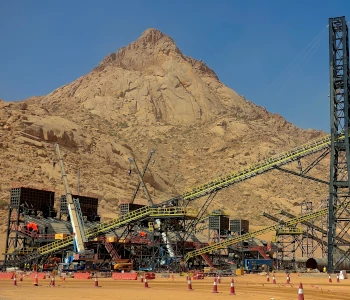-
Call Us +971 67657121
-
Send Message [email protected]
-
Our Location UMM DEARA, AL TAWOON NEW INDUSTRIAL AREA, UMM AL QUIWAN
Conveyor Belt
Conveyor Belt

A conveyor belt is composed of a variety of specialized compounds, each designed for optimal performance in specific applications. These compounds include natural rubber, which offers excellent elasticity and resistance to abrasion; styrene-butadiene rubber blends, which combine the benefits of natural and synthetic rubbers for improved durability; and nitriles, known for their resistance to oils and fuels.
Other notable materials include butyl rubber, recognized for its airtight properties; ethylene propylene-based polymers, which provide outstanding weather resistance and flexibility; polychloroprene, valued for its chemical and heat resistance; as well as polybutadiene, which has high resilience and wear resistance. Additionally, polyvinyl chloride (PVC) is often used for its versatility and ease of manufacturing, while urethanes offer excellent flexibility and abrasion resistance. Silicones are also utilized due to their high temperature resistance and flexibility in extreme conditions.
Each of these elastomers possesses distinct advantages, making them suitable for varying ranges of properties and operating environments. This diversity allows manufacturers and end-users to select the most appropriate material based on factors such as load capacity, environmental exposure, and operational durability. As a result, conveyor belts can be tailored to meet the specific demands of different industries, ensuring optimal performance and longevity
Rubber-Renowned for its exceptional durability and impact resistance, rubber is the material of choice for heavy-duty applications, particularly in industries such as mining, quarrying, and construction. Its high tensile strength enables it to withstand the harsh conditions often encountered in these sectors. Premium products, such as the Fenner Dunlop Patriot X line, are specifically engineered to perform under extreme conditions, making them ideal for transporting materials such as crushed stone, cement, and sand, where reliability and longevity are paramount.
PVC (Polyvinyl Chloride) : PVC belts offer a lightweight and economical solution, making them highly sought after in industries such as food processing, packaging, and pharmaceuticals. These belts are notable for their excellent resistance to water and a wide range of chemicals, which contributes to their durability in various environments. Additionally, the non-porous surface of PVC belts facilitates easy sanitization, making them suitable for stringent hygiene requirements. A prime example of this type of product is the YAVA Mechanical Parts 820-K450-C1 Plastic Conveyor Belt, known for its efficiency in handling diverse materials.
Modular Plastic: Composed of interlocking plastic sections, modular plastic belts provide unparalleled flexibility and ease of maintenance. This design allows users to quickly and efficiently clean or repair the belts by replacing only the individual sections that may become worn or damaged. Their adaptability makes them suitable for various configurations, including straight, curved, or inclined pathways, and they are commonly employed in the food and beverage industry, where hygiene and operational efficiency are essential. A representative product in this category is the HABASIT Flat Top Plastic Conveyor Belt, M5015, known for its robustness and functionality.
Metal (Stainless Steel/Wire Mesh): Constructed using high-grade stainless steel sheets or woven wire mesh, metal conveyor belts are revered for their unmatched strength and durability. These belts are specifically designed to resist extreme temperatures—both high and low—as well as corrosion, making them ideal for demanding applications such as baking, heat treating, and any food processing tasks that require regular washdown. Their robustness ensures they can perform reliably in challenging industrial environments.
Fabric (Nylon/Polyester): Fabric belts, typically made from nylon or polyester, represent lighter-duty and more cost- effective options for loading and transporting goods. They are frequently used in applications involving packaged products and agricultural materials. These belts offer a good balance of impact resistance and flexibility, making them suitable for various operational demands. Their lightweight nature allows for easier maneuverability, contributing to efficient handling processes across multiple industries.

